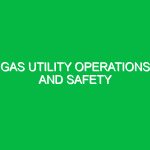Introduction to Utility Line Locating and Excavation Safety
Utility line locating and excavation safety is a vital aspect of the Health, Safety, and Environment (HSE) domain, ensuring that underground utilities are accurately identified and protected during excavation activities. Anyone who has ever watched a construction crew work knows how easily things can go wrong when digging begins. A single misstep can lead to catastrophic events, including explosions or service interruptions. Thus, understanding the principles of utility line locating and excavation safety is not just prudent; it is imperative.
Utility line locating refers to the process of identifying the specific locations of underground utilities such as water, gas, electricity, and telecommunication lines before any excavation work commences. This practice is essential for preventing accidents, avoiding costly damages, and ensuring compliance with legal regulations. The relevance of utility line locating extends beyond mere compliance; it embodies a commitment to safety for workers and the public alike.
Identifying Hazards and Risks Associated with Utility Line Locating and Excavation
The risks associated with utility line locating and excavation are multifaceted. They can vary depending on geographical location, type of utility, and specific site conditions. Here are some of the primary hazards:
1. Striking Underground Utilities
One of the most significant risks during excavation is accidentally striking an underground utility line. This can result in severe injuries or fatalities, not to mention property damage. For instance, a contractor in Texas once accidentally breached a gas line while digging. The subsequent explosion not only injured several workers but also disrupted services for an entire neighborhood.
2. Ground Stability Hazards
Excavation can destabilize the ground, resulting in cave-ins or collapses. This risk is particularly acute in areas with loose soil or where prior excavation has occurred. The Occupational Safety and Health Administration (OSHA) emphasizes the importance of proper shoring and bracing techniques to mitigate this risk.
3. Tripping and Falling Hazards
The presence of equipment, materials, and uneven surfaces increases the likelihood of slips, trips, and falls on excavation sites. A worker can easily trip over exposed utility lines or tools left lying around, leading to injuries that can sideline them for extended periods.
4. Environmental Hazards
Excavation activities can disturb the surrounding environment, leading to issues like soil erosion or contamination of water supplies. For instance, a construction project near a river in California caused sediment runoff that affected local aquatic life, demonstrating the need for environmental precautions in excavation practices.
5. Electrocution Risks
When digging near electrical lines, there is always a danger of electrocution. A worker in Florida was electrocuted while digging without proper utility line locating. This tragic incident underscores the necessity of ensuring that all utility lines are accurately marked before any excavation begins.
Best Practices and Safety Precautions for Utility Line Locating and Excavation
To mitigate the hazards outlined above, several best practices and safety precautions can be implemented.
1. Conducting Utility Line Surveys
Before any excavation, it is crucial to conduct a thorough survey of the area using both above-ground and underground locating technologies. Ground Penetrating Radar (GPR) is an effective tool that provides an image of what lies beneath the surface. In my experience, using GPR alongside traditional utilities marking methods has significantly lowered the risk of accidents.
2. Establishing a Clear Communication Plan
Communication is key. Ensure that all team members are aware of the location of utility lines and the specific precautions that need to be taken. Utilize marked maps that highlight utility locations and distribute them to all workers involved in the excavation process.
3. Implementing Excavation Safety Measures
Utilize protective measures such as trench boxes and shoring to prevent cave-ins. OSHA regulations stipulate that any trench deeper than five feet must have adequate support systems in place. Regular inspections of these supports during excavation can catch potential failures before they lead to accidents.
4. Personal Protective Equipment (PPE)
PPE is a must on any excavation site. Hard hats, steel-toed boots, gloves, and high-visibility vests can protect workers from various hazards. Remember, PPE is only effective if it is used consistently and properly.
5. Training and Awareness Programs
Regular training sessions for all employees can help instill a culture of safety on excavation sites. Familiarize workers with the potential hazards and the importance of utility line locating. In my previous role as a safety officer, I found that hands-on training effectively reinforced safety concepts, making workers more aware of their surroundings.
6. Emergency Preparedness
No plan is complete without an emergency preparedness strategy. Establish clear protocols for what to do in the event of an accident, such as striking a utility line. Ensure all team members know how to respond quickly and effectively, including calling emergency services and securing the site.
Regulations and Standards Governing Utility Line Locating and Excavation Safety
Numerous regulations govern utility line locating and excavation safety, aimed at protecting workers and the public.
1. OSHA Regulations
The Occupational Safety and Health Administration (OSHA) has set forth regulations that guide excavation safety practices. OSHA‘s standards for excavation (29 CFR 1926 Subpart P) mandate specific guidelines regarding trench safety and the protection of workers.
2. American National Standards Institute (ANSI)
ANSI provides standards that address utility locating, aiming to enhance safety and minimize the risks associated with underground utility work. Compliance with these standards is essential for contractors and utility companies.
3. Local and State Regulations
In addition to federal regulations, many states have their own guidelines regarding utility line locating and excavation. For instance, California mandates that contractors must call 811 to have utilities marked before digging begins, a practice that has significantly reduced the number of accidents.
Conclusion: A Commitment to Safety
Utility line locating and excavation safety is not just a regulatory requirement; it is a commitment to the health and safety of workers, the public, and the environment. By understanding the risks, implementing best practices, and adhering to regulations, we can significantly minimize the chances of accidents and ensure smoother, safer excavation processes.
While the topic may seem daunting, a proactive approach to safety can foster a culture where workers feel empowered to prioritize their well-being. In the end, utility line locating and excavation safety is about protecting lives and ensuring that our communities can thrive without disruption. Whether you are a contractor, a safety officer, or a worker on the ground, remember: safety is a shared responsibility.


